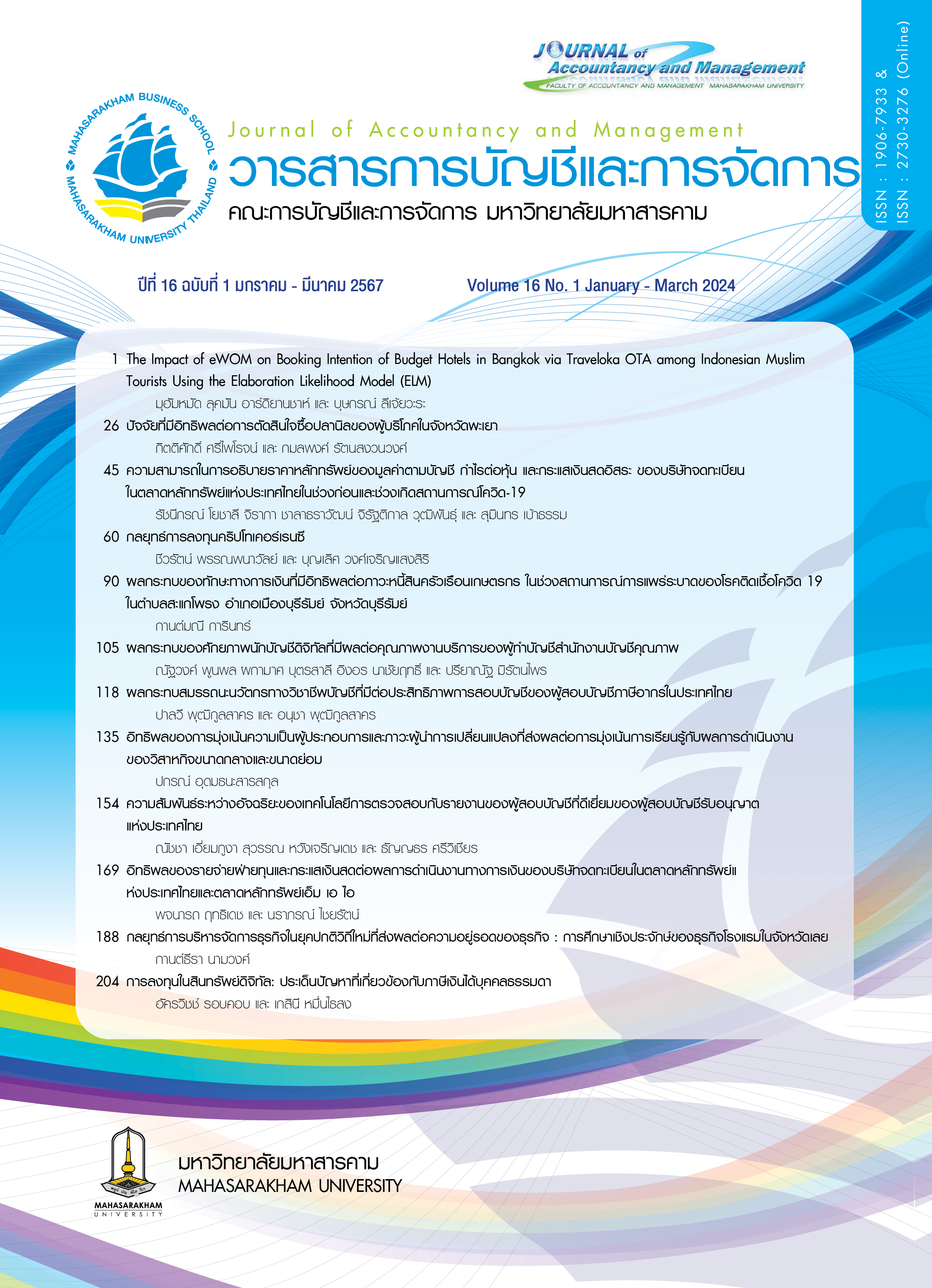ความสัมพันธ์ระหว่างอัจฉริยะของเทคโนโลยีการตรวจสอบ กับรายงานของผู้สอบบัญชีที่ดีเยี่ยมของผู้สอบบัญชีรับอนุญาตแห่งประเทศไทย
Main Article Content
บทคัดย่อ
การศึกษาครั้งนี้มีวัตถุประสงค์ เพื่อศึกษาความสัมพันธ์ระหว่างอัจฉริยะของเทคโนโลยีการตรวจสอบกับรายงานของผู้สอบบัญชีที่ดีเยี่ยมของผู้สอบบัญชีรับอนุญาตแห่งประเทศไทย โดยใช้แบบสอบถามเป็นเครื่องมือในการรวบรวมข้อมูลจากผู้สอบบัญชีรับอนุญาตแห่งประเทศไทย จำนวน 305 คน สถิติที่ใช้ในการวิเคราะห์ข้อมูล ได้แก่ การวิเคราะห์สหสัมพันธ์แบบพหุคูณและการวิเคราะห์การถดถอยแบบพหุคูณ ซึ่งอัจฉริยะของเทคโนโลยีการตรวจสอบได้ถูกกำหนดเป็นตัวแปรอิสระที่มีความสัมพันธ์และผลกระทบกับรายงานของผู้สอบบัญชีที่ดีเยี่ยมของผู้สอบบัญชีรับอนุญาตแห่งประเทศไทย ผลการวิจัยพบว่าอัจฉริยะของเทคโนโลยีการตรวจสอบ ด้านแผนการตรวจสอบแบบพลวัต และด้านนวัตกรรมการควบคุมภายใน มีความสัมพันธ์และผลกระทบเชิงบวกกับรายงานของผู้สอบบัญชีที่ดีเยี่ยม ดังนั้นผู้สอบบัญชีรับอนุญาตแห่งประเทศไทยควรให้ความสำคัญการวางแผนการตรวจสอบ โดยกำหนดเป้าหมาย ระยะเวลา ภาระหน้าที่ ขอบเขตของวิธีการตรวจสอบในการปฏิบัติงานตามระเบียบแบบแผนที่กำหนดไว้ สามารถ
ช่วยให้ผู้สอบบัญชีได้ตรวจสอบและปรับปรุงความถูกต้องและความสมบูรณ์ของข้อมูลได้อย่างรวดเร็วขึ้น รวมถึงความสำคัญของการควบคุมภายใน การพิจารณารับงานสอบบัญชี ผู้สอบบัญชีควรมีการพิจารณาอย่างรอบคอบในการวางแผนการให้รัดกุมมากยิ่งขึ้นเพื่อให้บรรลุวัตถุประสงค์อย่างมีประสิทธิภาพ
Downloads
Article Details

อนุญาตภายใต้เงื่อนไข Creative Commons Attribution-NonCommercial-NoDerivatives 4.0 International License.
บทความที่ได้รับการตีพิมพ์เป็นลิขสิทธิ์ของวารสารการบัญชีและการจัดการ
ข้อความที่ปรากฏในบทความแต่ละเรื่องในวารสารวิชาการเล่มนี้เป็นความคิดเห็นส่วนตัวของผู้เขียนแต่ละท่านไม่เกี่ยวข้องกับมหาวิทยาลัยมหาสารคาม และคณาจารย์ท่านอื่นๆในมหาวิทยาลัยฯ แต่อย่างใด ความรับผิดชอบองค์ประกอบทั้งหมดของบทความแต่ละเรื่องเป็นของผู้เขียนแต่ละท่าน หากมีความผิดพลาดใดๆ ผู้เขียนแต่ละท่านจะรับผิดชอบบทความของตนเองแต่ผู้เดียว
เอกสารอ้างอิง
กนกศักดิ์ สุขวัฒนาสินิทธิ์. (2561). ปัจจัยที่มีผลต่อคุณภาพของผู้สอบบัญชีรับอนุญาตในยุคไทยแลนด์ 4.0. กรุงเทพฯ : คณะบัญชี มหาวิทยาลัยศรีปทุม.
กรมสรรพากร. (2560). ความแตกต่างระหว่าง TA และ CPA. ค้นเมื่อ 2 กันยายน 2563, จาก
https://www.rd.go.th/publish/25631.0.html
จารินยา แก้วสุริยา. (2560). ผลกระทบของคุณภาพในการสอบบัญชีและความต่อเนื่องในการสอบทานงานสอบบัญชีที่มีต่อความน่าเชื่อถือในการสอบบัญชีของผู้สอบบัญชีรับอนุญาตในประเทศไทย. วิทยานิพนธ์บัญชี
มหาบัณฑิต คณะวิทยาการจัดการ มหาวิทยาลัยสงขลานครินทร์.
ชาญชัย ตั้งเรือนรัตน์. (2560). การใช้รายงานของผู้สอบบัญชีแบบใหม่ : ประสบการณ์แรก. วารสารวิชาชีพบัญชี,
(38), 5-21.
ชุตินุช อินทรประสิทธิ์. (2561). การสอบบัญชีในยุค Big Data. สุทธิปริทัศน์, 32(103), 189–202.
ชุรีรัตน์ ต๊ะตุ้ย จีราภรณ์ พงศ์พันธ์พัฒนะ และ ณัฐนันท์ ฐิติยาปราโมทย์. (2565). ความชาญฉลาดในการสังเกตและ สงสัยเยี่ยงผู้ประกอบวิชาชีพที่ส่งผลต่อประสิทธิภาพการปฏิบัติงานสอบบัญชีของผู้สอบบัญชีรับอนุญาตใน ประเทศไทย. วารสารบริหารธุรกิจและศิลปศาสตร์ราชมงคลล้านนา, 10(1), 41-56.
ธัญชนก เรือนแก้ว สุขเกษม ลางคุลเสน และ ณัฐนันท์ ฐิติยาปราโมทย์. (2563). ความเป็นเลิศในวิธีการสอบบัญชีและคุณภาพรายงานการตรวจสอบของผู้สอบบัญชีภาษีอากรในประเทศไทย. วารสารเทคโนโลยีภาคใต้,
(1), 99-107.
ธิดารัตน์ ยงยศยิ่ง. (2560). ผลกระทบของความครอบคลุมในการวางแผนการสอบบัญชี คุณภาพการสอบบัญชีที่มีต่อความยั่งยืนในการสอบบัญชีของผู้สอบบัญชีรับอนุญาตในประเทศไทย. วิทยานิพนธ์บัญชีมหาบัณฑิต
คณะวิทยาการจัดการ มหาวิทยาลัยสงขลานครินทร์.
ธีรเศรษฐ์ เมธจิรนนท์. (2562). แนวโน้มวิชาชีพบัญชีในปี2020 เตรียมพร้อมและปรับตัว. ค้นเมื่อ 20 มีนาคม 2564, จาก https://www.dharmniti.co.th/acc-knowledge-acctrendin2020/
นิพันธ์ เห็นโชคชัยชนะและศิลปพร ศรีจั่นเพชร. (2559). การสอบบัญชี. กรุงเทพฯ : ทีพีเอ็น เพรส
บุญชม ศรีสะอาด. (2556). การวิจัยเบื้องต้น. กรุงเทพฯ : ทริ๊ปเพิล.
ปิยพงศ์ ประไพศรี และกาญจนา นันทพันธ์. (2563). แนวทางการพัฒนาวิชาชีพของผู้ประกอบวิชาชีพบัญชีในยุคดิจิทัล. วารสารมหาจุฬานาครทรรศน์, 7(12), 421-435.
พัชรินทร์ เลี่ยมดวงแข. (2554). ความพึงพอใจของผู้สอบบัญชีในการนำโปรแกรม Audit Command Language (ACL) มาใช้ในการตรวจสอบบัญชีในบริษัทตรวจสอบบัญชีแห่งหนึ่ง. วิทยานิพนธ์บริหารธุรกิจมหาบัณฑิต. คณะสังคมศาสตร์ มหาวิทยาลัยศรีนครินทรวิโรฒ.
ภัชรพรรณ์ กรรโณ และประเวศ เพ็ญวุฒิกุล. (2561). ปัจจัยที่มีผลกระทบต่อคุณภาพการเปิดเผยการสื่อสารเรื่องสำคัญในการตรวจสอบในรายงานของผู้สอบบัญชีรับอนุญาตแห่งประเทศไทย. วารสารมหาจุฬานาครทรรศน์,
(3), 926-942.
วิชิต สุรดินทร์กูร ศรีปริญญา ธูปกระจ่าง และ วรเดช จันทรศร. (2563). ความโปร่งใสขององค์การธุรกิจไทยตาม
การรับรู้ของผู้สอบบัญชีรับอนุญาต. วารสารสันติศึกษาปริทรรศน์มจร, 8(3), 912-925.
วิไลวรรณ โพนศิริ. (2562). ผลกระทบของความเป็นมืออาชีพที่มีต่อคุณภาพการสอบบัญชีของผู้สอบบัญชีรับอนุญาตในเขตกรุงเทพมหานคร. วารสารวิทยาการจัดการปริทัศน์, 21(1), 125-136.
เยาวนาถ หมานหมุ้ย. (2559). ผลกระทบของจรรยาบรรณของผู้สอบบัญชีต่อประสิทธิภาพระบบการควบคุมภายในและคุณภาพงานสอบบัญชีของผู้สอบบัญชีสหกรณ์. วิทยานิพนธ์บัญชีมหาบัณฑิต คณะวิทยาการจัดการ
มหาวิทยาลัยสงขลานครินทร์.
เยาวลักษณ์ ชาติบัญชาชัย และโสภณ เพิ่มศิริวัลลภ. (2559). คำถามที่พบบ่อย (FAQ) เกี่ยวกับ Big data และ Data Analytics. Boardroom, 48, 30-35. ค้นเมื่อ 1 พฤศจิกายน 2563, ,จาก https://www.thai-
iod.com/imgUpload/file/Library/IT%20Governance/______________(FAQ)%20_________%20Big%
-Data%20___%20Data%20analytics%20-%20IOD%20Boardroom%20Vol_48%20Issue
%205_2016.pdf
สภาวิชาชีพบัญชี ในพระบรมราชูปถัมภ์. (2563). ยกระดับการตรวจสอบบัญชีด้วยนวัตกรรมการตรวจสอบ. ค้นเมื่อ 2 พฤศจิกายน 2563 ,จาก https://www.tfac.or.th/Article/Detail/127427
สภาวิชาชีพบัญชี ในพระบรมราชูปถัมภ์. (2564). ข้อมูลของผู้สอบบัญชีรับอนุญาต(เฉพาะท่านที่ประสงค์เปิดเผยข้อมูลเพื่อการติดต่อ). ค้นเมื่อ 11 มกราคม 2564, จาก https://eservice.tfac.or.th/
fap_registration/cpa-contactlist?condition=1&district_hidden=&province_hidden=59
&geography_hidden=&district=0
สุเมธ กิตติอารีพงศ์ และวชิระ บุญยเนตร. (2563). การสำรวจการรับรู้เกี่ยวกับการใช้โปรแกรมการวิเคราะห์ข้อมูลเชิง ลึกเพื่อการตรวจสอบในสำนักงานสอบบัญชีขนาดเล็ก. วารสารสภาวิชาชีพบัญชี, 2(6), 20-51.
สาธิยา กลิ่นสุคนธ์ กรไชย พรลภัสรชกร และ คมกริช วงศ์แข. (2561). ปัจจัยที่มีผลต่อการมุ่งเน้นความฉลาดทางการตรวจสอบภายในหลักฐานเชิงประจักษ์จากบริษัทจดทะเบียนในตลาดหลักทรัพย์แห่งประเทศไทย.
RMUTT Global Business and Economics Review, 13(1), 27-42.
อาภากร นาหนองขาม และเนตรดาว ชัยเขต. (2565). ผลกระทบของการรับรู้สมรรถนะการสอบบัญชีที่มีต่อการรับรู้ คุณภาพรายงานของผู้สอบบัญชีของนักวิชาการตรวจเงินแผ่นดิน สำนักงานตรวจเงินแผ่นดิน วารสารการ
จัดการและการพัฒนา มหาวิทยาลัยราชภัฏอุบลราชธานี, 9(2), 97-113.
Ali, M., Abdullah, S., & Saad, G. (2022). The Effect of Activating Artificial Intelligence techniques on Enhancing Internal Auditing Activities "Field Study". Alexandria Journal of Accounting Research, 6(3), 1-40.
Anderson, W. (1988). “Likert Scales”, Education Research Methodology and Measurement : An International Handbook. John, D.Keeves, eds, Victoria : Pergamon.
Aytan, B., & Dimitrios, M. (2020). The Effects of Digitalization on Auditing : A Study Investigating the Benefits and Challenges of Digitalization on the Audit Profession. Publication No. INF20-040. Stockholm, Sweden : Department of Informatics , School of Economics and Management Lund University.
Barr-Pulliam, D., Liburd, H., & Sanderson, K. (2022). The Effects of the Internal Control Opinion and Use of Audit Data Analytics on Perceptions of Audit Quality, Assurance, and Auditor Negligence. Auditing : A Journal of Practice & Theory, 41(1), 25-48.
Black, K. (2006). Business Statistics for Contemporary Decision Making. (4th ed.). New York : John Wiley & Sons.
Dai, J. (2017). Three essays on audit technology: audit 4.0, blockchain, and audit app.
New Brunswick, United States : Management Rutgers, The State University of New Jersey.
Dai, J., & Vasarhelyi, A. M. (2016). Imagineering Audit 4.0. Journal of Emerging Technologies in Accounting, 13(1), 1-15.
Eulerich, M., Masli, A., Pickerd, J., & Wood, D. (2020). The Impact of Audit Technology on Audit
Outcomes: Technology-Based Audit Techniques’ Impact on Internal Auditing. Contemporary Accounting Research, 40(2), 981-1012.
Field, A. (2000). Discovering Statistics Using SPSS for Windows. New York : Sage Publication.
Hair, J., Black, W., & Erson, R.(2006). Multivariate data analysis. New Jersey : Pearson.
Manson, S., Mccartney, S., & Sherer, M. (2007). Current Issues in Auditing. Edition3. London : SAGE Publications Ltd.
Oweis, K. (2022). Automation of audit processes, and what to expect in the Future. Journal of
Management Information and Decision Sciences, 25(4), 1-9.
The Association of Chartered Certified Accountants. (2019). Audit and technology. Glasgow The Association of Chartered Certified Accountants publisher.
Vasarhelyi, M., & Lin, W. (1985). EDP auditing instruction using an interactive generalized audit software. Journal of Accounting Education, 3(2), 79-89.
Weins, S., Bastian, A., & Tawe, W. (2016). Rethinking The Future of Auditing: How an Integrated Continuous Auditing Approach Can Leverage the Full Potential of Continuous Auditing. EconStor Preprints 146401, ZBW - Leibniz Information Centre for Economics.


